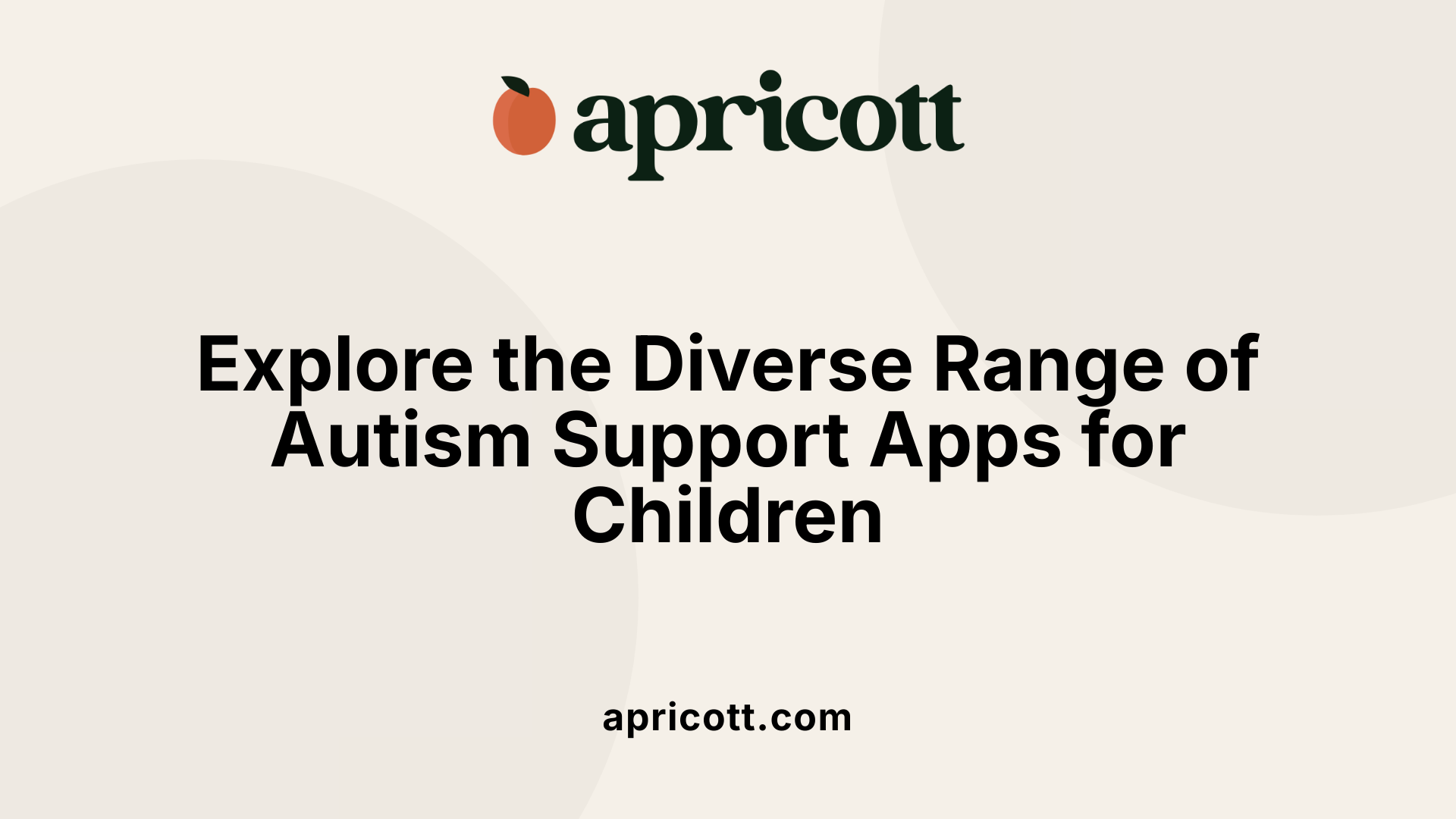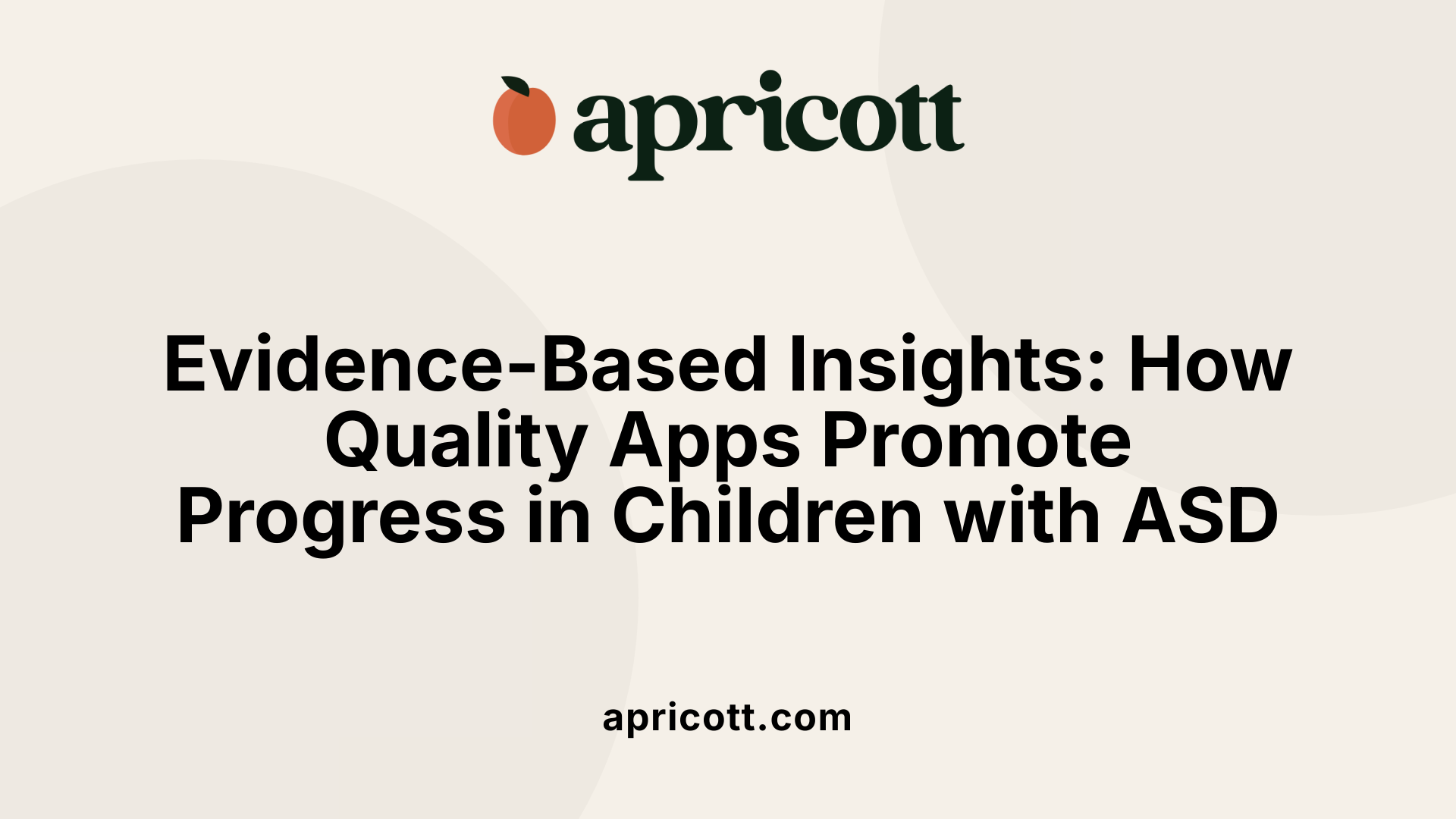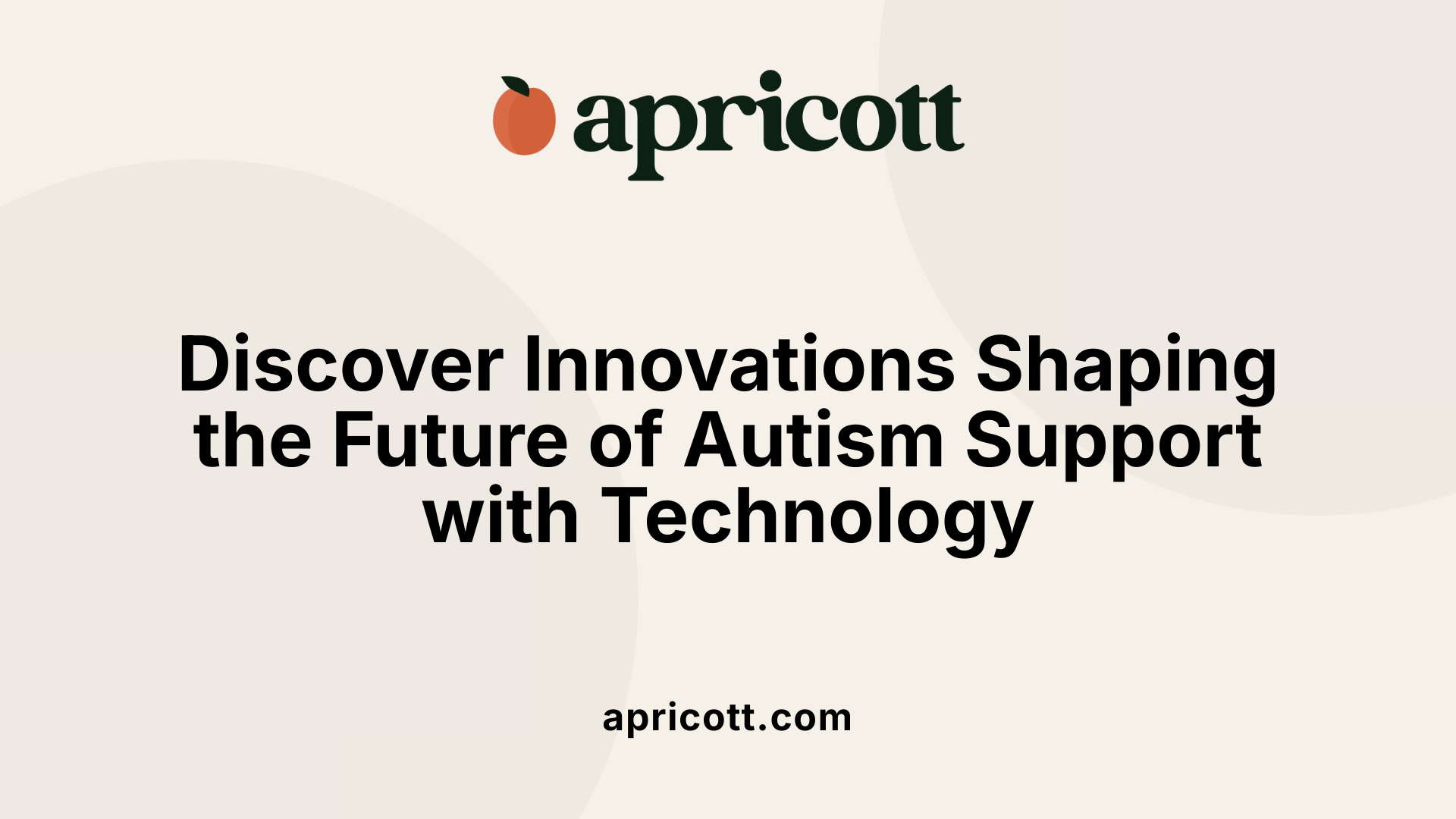July 29, 2025
Harnessing Technology to Enhance Autism Support and Development
In recent years, autism spectrum disorder (ASD) has seen increased awareness and diagnosis, prompting a surge in digital tools aimed at supporting children's developmental and daily living needs. Autism apps have become vital resources for parents, educators, and therapists, offering tailored interventions, skills development, and behavioral monitoring. This article explores the landscape of autism apps for children, their key features, benefits, and how to select the most effective tools to help children thrive.

There is a wide range of apps tailored to support children with Autism Spectrum Disorder (ASD). These include educational apps that foster learning of core skills such as math, reading, and vocabulary, as well as communication apps designed to assist nonverbal or minimally verbal children. Behavioral apps focus on positive reinforcement and tracking behaviors to manage routines, while sleep apps provide support for children facing sleep difficulties. Social skills apps help children recognize emotions, improve conversational abilities, and navigate social situations effectively.
Some notable examples include the Autism & PDD Social Stories app, which prepares children for holidays and events, and Proloquo2Go, an augmentative communication app with thousands of symbols. Additionally, apps like Behavior World promote positive behavior reinforcement, and Birdhouse for autism tracks behaviors and health indicators. Sensory apps such as White Noise and SleepBot assist in calming children and establishing sleep routines.
Autism apps serve multiple functions aimed at enhancing various developmental domains. They help children recognize and express emotions, manage daily routines through visual schedules, and improve social interaction skills. Many apps incorporate cognitive exercises that develop language, reading, and reasoning abilities.
For example, MITA (My Intelligent TherapeutaAid) is a language therapy app supported by clinical studies showing significant improvements in language skills. It features adaptive exercises targeting vocabulary, syntax, and higher language functions — including adjectives, verbs, and pronouns. Other tools like Choiceworks facilitate decision-making and impulse control using visual schedules.
Furthermore, several apps are designed to monitor behaviors, moods, and medication adherence, enabling parents and therapists to identify patterns or triggers. Sensory integration tools aid in calming children overloading from stimuli, while social story apps assist in understanding social cues, preparing children for outings or school activities.
Parents and educators seeking trusted recommendations can access curated lists from various reputable sources. The Pacific Autism Center of Education offers extensive app lists tailored to emotional, language, social, and routines support. The Center for Technology and Disability provides an app matrix with detailed descriptions and ratings.
Organizations like Autism Speaks, Bridging Apps, and Raising Children also review and recommend high-quality autism apps. These resources often include assessments of app efficacy, design quality, and accessibility features.
Webinars, online guides, and downloadable resources help guide decisions, ensuring the chosen apps complement therapy plans and meet individual child needs. For instance, the Autism Helper offers community support and training for app integration into daily routines.
Yes, many free autism apps are accessible to support various developmental needs. Examples include 'Autism Therapy with MITA,' which offers free puzzles for cognitive development, and 'Let Me Talk,' a free AAC app that helps with speech. 'Autism Emotion' assists children in recognizing feelings, and 'Model Me Going Places' provides social story support for navigating community environments.
These free options are often supported by generous nonprofit organizations, educational institutions, or open-source developers. Searching app stores for 'Autism Apps' and exploring autism resource websites can uncover additional free tools tailored for different age groups and abilities.
Among the most widely used are Proloquo2Go, which provides speech-generating capabilities; Choiceworks, with visual schedules and social stories; and Pictello, enabling customization of social narratives. The Zones of Regulation app helps children understand and regulate emotions, while Behavior World offers reinforcement strategies.
Apps like Autism Tracker Pro are invaluable for monitoring behavior patterns, moods, and medication schedules. Sensory apps such as White Noise and Melody Maker help children manage sensory overloads. Additional popular tools include the Autism iHelp series, which promotes language and social skills, and the Autism & PDD Social Stories app, which prepares children for specific scenarios.
Apps facilitate independence by providing platforms for expressive communication, including picture, text, and speech outputs tailored to children's developmental levels. They make it easier for children to request, comment, and participate in conversations.
In social skill development, apps simulate interactions, teach facial recognition, and help interpret social cues, promoting better understanding of social dynamics. For daily routines, visual schedules outline steps for morning routines, school activities, or bedtime, helping children follow sequences independently.
Behavior tracking apps give caregivers insights into triggers, enabling tailored interventions. These digital tools also motivate children with engaging activities, increasing their confidence and participation in everyday activities.
Effective autism apps should be customizable, allowing parents and professionals to tailor content to the child's abilities and interests. Visual supports like pictures, symbols, and videos should be clear and easy to navigate.
Look for apps with immediate feedback, reinforcement systems, and engaging interfaces that motivate continued use. Compatibility with various devices, ease of use, and backup options for data are essential.
Additionally, apps that promote routine management with visual schedules, timers, and countdowns improve independence. Features supporting progress tracking and data sharing with therapists enhance therapy effectiveness.
Scientific studies demonstrate that well-designed autism apps can significantly increase skills like language, social interaction, and emotional understanding. Clinical trials, such as one involving 6,454 children over three years, showed that using the MITA app resulted in 120% greater improvements in language scores compared to non-users.
Features like visual presentation, customization, and alignment with evidence-based practices, including ABA and Pivotal Response Treatment, boost effectiveness. When integrated into comprehensive intervention strategies, apps serve as valuable adjuncts to therapy.
Trusted online platforms like the Center on Technology and Disability, Autism Speaks, and Common Sense Media provide comprehensive reviews and lists of autism apps. Many organizations offer webinars and downloadable guides to assist in app selection.
These resources often include ratings based on usability, evidence of effectiveness, and accessibility. Consulting with professionals and support groups can further tailor app choices to individual needs.
By leveraging these curated resources and understanding the diverse functionalities available, caregivers and educators can make informed decisions to support children with ASD effectively.

Research suggests that well-designed autism apps can positively influence the developmental trajectory of children with ASD. When used consistently and as part of a broader intervention plan, these digital tools can enhance social skills, facial recognition, and communication abilities.
Rigorous studies, including randomized controlled trials, have demonstrated improvements in targeted behaviors through apps such as 'Yface' and Social Stories. These benefits are often more pronounced in younger children, especially those who are verbal, as well as in females and gender-diverse individuals.
The success of an app often depends on its format—visual presentation, use of animations, and personalization matter greatly. In-session training and inclusion of real-life or 3D elements help translate skills learned digitally to real-world settings.
Despite these promising results, the educational and therapeutic value varies across the available apps. High-quality tools with evidence-based content are essential for achieving meaningful progress.
Overall, adopting effective apps can support a child's learning journey, but they should complement other therapies and interventions for optimal results.
 When supporting children with autism spectrum disorder (ASD), integrating digital apps into therapeutic and educational programs can enhance learning and development. These tools should complement traditional therapies such as Applied Behavior Analysis (ABA), speech therapy, and occupational therapy, fitting into a comprehensive support plan.
When supporting children with autism spectrum disorder (ASD), integrating digital apps into therapeutic and educational programs can enhance learning and development. These tools should complement traditional therapies such as Applied Behavior Analysis (ABA), speech therapy, and occupational therapy, fitting into a comprehensive support plan.
Matching Apps to Individual Needs is crucial. Each child has unique strengths, interests, and developmental goals. Professionals can help select apps that align with these requirements, ensuring that activities are engaging and relevant. For example, visual supports or picture exchange communication apps are ideal for non-verbal children, while routines management apps help improve independence.
Customization features in apps play a vital role. Adjusting content—like choosing the number of pictures, personalizing categories, and tailoring activities—helps meet the child's specific abilities and learning style. The use of modeling, reinforcement, and immediate feedback within the apps can motivate children and promote skill acquisition.
Professional Guidance and Ongoing Assessment are key to successful integration. Therapists, educators, and caregivers should work together to monitor progress, evaluate the effectiveness of app use, and adapt strategies as needed. Regular assessments help in tracking development, understanding behavioral responses, and refining intervention goals. Professionals can also provide training for caregivers on effective app use, ensuring consistent application across settings.
Why is Personalization and Progress Tracking Important? Customizing app activities ensures that children remain engaged and motivated, supporting higher success rates in learning new skills. Personalized content resonates more effectively with a child's interests and developmental phase.
Meanwhile, progress tracking offers valuable insights. By analyzing data—such as skill improvements, behavioral patterns, and engagement levels—caregivers and professionals can make informed decisions. They can adjust app activities or intervention strategies to better support the child's growth.
| Aspect | Consideration | Benefits |
|---|---|---|
| Customization | Adjust content to child's needs | Improved engagement and relevance |
| Progress Monitoring | Regular assessment of skills | Better-informed strategies and goal setting |
| Professional Support | Guidance in selecting and using apps | Maximizes benefits and integration |
| Child-Centered Design | Features supporting communication, routines, and social skills | Increased independence and social competence |
In conclusion, thoughtfully combining apps with traditional therapies, personalised content, and continual assessment creates a dynamic, responsive environment that fosters substantial growth. When professionals actively guide their use, digital tools can become powerful allies in developing essential skills and enhancing quality of life for children with ASD.

Supporting children with autism involves a wide array of programs and school choices tailored to diverse needs. Specialized schools dedicated to autism provide structured environments focused on developing social, communication, and behavioral skills. Early intervention services are crucial, offering therapies and support shortly after diagnosis to foster development. Community-based programs, such as those run by Autism Speaks, Autism Society, and Easterseals, serve as vital resources for families seeking guidance and services.
State and local agencies play an essential role in providing resources, training, and access to services for children at various developmental stages. Examples include Ohio's OCALI and the Interagency Work Group on Autism, which help coordinate efforts across education, healthcare, and social services.
Educational programs are often personalized, emphasizing social skills, communication, and transition support into adulthood. These programs are supported through federal and state initiatives that promote inclusive education.
Furthermore, programs like the Autism Scholarship Program offer financial assistance for families to choose suitable educational settings. Family support organizations help families navigate complex systems, advocating for appropriate services and funding options like Medicaid, SSI, and CHIP.
In essence, a combination of specialized schools, early intervention, community services, and policy support forms a comprehensive network that aids children with autism throughout their growth. This integrated approach aims to maximize each child's potential and support their families effectively.
The START (Screening Tools for Autism Risk using Technology) app exemplifies innovative technology aiding in early autism detection. It is a computerized screening tool that uses engaging games, questions, images, and activities on a tablet to evaluate children’s social preferences, sensory interests, and motor skills.
Designed for accessibility, START employs parental questionnaires and direct interaction with children, making it suitable for diverse environments, including low-resource settings. Its effectiveness was demonstrated through testing with children aged two to seven in Delhi, India.
The app’s accuracy is notable: it correctly identified neurodevelopmental disorders in 86% of cases and specifically autism in 78%. Community healthcare workers can utilize START efficiently, even amidst noisy or distracting surroundings, facilitating early screening where specialists are scarce.
By enabling non-specialists to identify children at risk, START supports timely diagnoses and intervention plans. Its affordability, ease of use, and adaptability make it an essential tool for expanding autism screening in underserved regions.
Looking ahead, technological advancements will continue transforming autism support. Artificial intelligence (AI) and machine learning are increasingly integrated into apps, allowing for more personalized and adaptive learning experiences.
Apps like MITA have demonstrated significant improvements in language development, showcasing how data-driven adjustments cater to individual progress. Future programs will likely incorporate real-time feedback, virtual reality environments, and biofeedback to enrich therapy and behavioral management.
Accessibility remains a priority, with ongoing efforts to enhance inclusive design. This includes multilingual support, customizable interfaces, and multi-sensory options to serve children across different cultural and developmental backgrounds.
Digital platforms will also expand to include virtual classrooms, teletherapy services, and integrated parent training modules—making support more flexible and comprehensive.
Inclusive design will dominate future developments, emphasizing universal accessibility principles. Apps will focus on removing barriers for non-verbal children, those with fine motor challenges, or limited vision and hearing.
Efforts are underway to implement voice recognition, image recognition, and haptic feedback to aid interaction. Customizable content will ensure that tools are tailored to each child's strengths and preferences.
Furthermore, collaboration with end-users—children, families, educators, and therapists—will guide iterative improvements, ensuring the technology remains user-friendly and effective.
Advancements in technology have the potential to revolutionize intervention strategies, enabling earlier detection, tailored therapy, and better self-management tools. For families, this means improved access, more engaging learning experiences, and enhanced independence and social inclusion for children.
Mobile and web-based apps facilitate ongoing monitoring of progress, fostering a proactive approach to intervention. Visual schedules, emotion regulation tools, and social stories -- supported by interactive apps -- help children navigate everyday challenges.
Overall, the expansion of autism-focused technology will contribute to better outcomes, higher quality of life, and greater inclusion, ultimately supporting children in reaching their full potential within their communities.
| Aspect | Current Examples | Future Directions | Impact and Accessibility |
|---|---|---|---|
| Support Programs | Specialized schools, early intervention, community resources | Integrated AI-driven therapies, virtual support | More tailored, inclusive, and accessible options |
| Autism Screening | START app in low-resource settings | Widespread adoption, real-time diagnostics | Earlier diagnosis and intervention potential |
| Design Improvements | Basic adaptive apps | Voice/image recognition, multi-sensory interfaces | Increased inclusivity for diverse needs |
| Intervention Strategies | Traditional therapies | Personalized, data-driven approaches, virtual platforms | Enhanced outcomes, better engagement |
| Overall Impact | Support varies across settings | Holistic, continuous support via technology | Improved quality of life, higher independence |
This evolving landscape signifies a future where digital tools are seamlessly integrated into autism support systems, opening new horizons for children and their families.
As autism support continues to evolve, technology and innovative apps play a crucial role in empowering children with ASD to reach their full potential. The availability of scientifically validated, user-friendly, and customizable apps enables families, educators, and clinicians to tailor interventions that meet individual needs. With ongoing advancements in accessibility, virtual reality, and data-driven personalization, the future promises even more effective tools for fostering communication, social skills, and independence, ultimately improving quality of life for children with autism and their families.